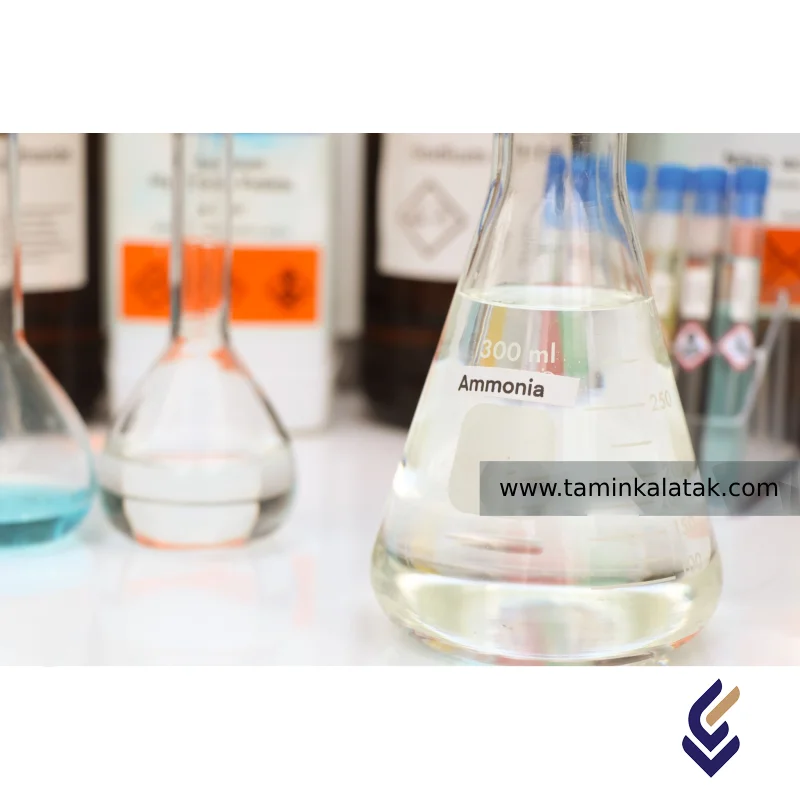Ammonia
Ammonia (NH₃) is a colorless, pungent, toxic gas that is highly soluble in water. It plays a crucial role in the chemical, agricultural, water treatment, and fertilizer industries. Ammonia is one of the most important base chemicals in the production chain of nitrogen-containing compounds and is available commercially in two primary forms: anhydrous ammonia (compressed gas) and aqueous ammonia (ammonium hydroxide solution).
Chemical Structure of Ammonia
-
Molecular Formula: NH₃
-
Molecular Geometry: Trigonal pyramidal
-
Bond Angle: Approximately 107.8°
-
Bonding Characteristics: One nitrogen atom bonded to three hydrogen atoms, with one lone pair of electrons on the nitrogen atom
Physical and Chemical Properties
| Property | Description |
|---|---|
| State at Ambient Conditions | Gas (or liquefied under pressure) |
| Odor | Strong, sharp, irritating odor |
| Boiling Point | –33.34 °C |
| pH (1M aqueous solution) | Approximately 11.6 |
| Water Solubility | Very high — 1 volume of water dissolves about 700 volumes of NH₃ gas |
| Solubility in Ethanol | Low |
Applications of Ammonia
Agriculture
-
Production of nitrogen fertilizers such as urea, ammonium nitrate, and ammonium phosphate
-
Used for soil pH adjustment in acidic soils
Chemical Industry
-
Feedstock for the production of nitric acid, amines, nitrates, sodium amide, and other nitrogen-based compounds
-
Used in the synthesis of resins and various organic nitrogen compounds
Refining and Petrochemical Industries
-
Acts as a CO₂ absorbent in steam methane reforming (SMR) processes
-
Used in demulsification, gas scrubbing, and pollution control systems
Water and Wastewater Treatment
-
Removes heavy metal ions such as copper, nickel, and lead
-
Used for pH control and odor suppression of sulfur-containing compounds
Food and Pharmaceutical Industries
-
Limited use as a disinfectant and pH regulator
-
Intermediate for the production of ammonium bicarbonate (baking agent) and certain nitrogen-based pharmaceuticals
Refrigeration Industry
-
Used as a high-efficiency industrial refrigerant (R-717)
-
Offers excellent thermal performance in chillers and cold storage systems
Advantages of Ammonia
-
Cost-effective nitrogen source for fertilizer production
-
Highly efficient industrial refrigerant
-
Strong alkaline solution for water purification and heavy metal removal
-
Useful solvent and reactant in specialized chemical syntheses
-
Can be produced domestically via the Haber–Bosch process (from nitrogen and hydrogen gases)
Disadvantages of Ammonia
-
Highly toxic upon inhalation or skin contact
-
Flammable under certain conditions (at high concentrations in air)
-
Extremely pungent and irritating odor
-
Strongly corrosive in concentrated form
-
Requires specialized pressurized equipment for safe storage and handling
Safety and Handling of Ammonia
GHS Classification
-
H331: Toxic if inhaled
-
H314: Causes severe skin burns and eye damage
Personal Protective Equipment (PPE)
-
Respirator with ammonia-specific cartridge filter
-
Chemical-resistant gloves
-
Safety goggles and face shield
-
Proper ventilation is mandatory; use in enclosed spaces only with active exhaust systems
Fire and Explosion Hazards
-
Ammonia itself is not spontaneously flammable, but can form explosive mixtures with air at certain concentrations
Storage Conditions
-
Store in corrosion-resistant steel tanks
-
Keep away from moisture and under controlled temperature
-
Facilities must include leak detection and emergency safety systems
Industrial Transportation
-
Transported in pressurized tankers or cylinders
-
Classified as hazardous material – UN 1005
Applications
| Applications | , , , |
|---|
Ammonia
| Products | Grade | Vapor pressure | Physical appearance | Solubility in water | Melting point | Density (at 20°C) |
|---|---|---|---|---|---|---|
| Ammonia | Common grades: industrial, laboratory, pharmaceutical, anhydrous | حدود 8.5 bar یا 850 kPa | Colorless gas with a pungent odor, or colorless liquid at low temperatures and under pressure. | Very high At -20 °C, 1 volume of water can absorb about 700 volumes of ammonia gas. | -77.7 °C | About 0.73 kg/m³ (gas) or 0.6819 g/cm³ (liquid at -33°C) |







